


Scholomance:


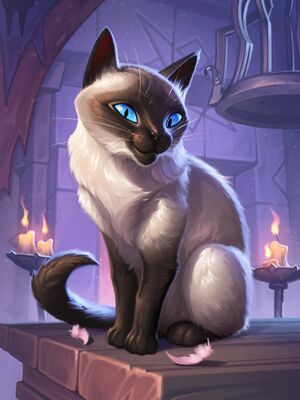
"Headmaster" Kel'Thuzad
We've seen and talked in deep length about Kel'thuzad in the Curse of Naxxramas segment when he first made his debut in Hearthstone. The Headmaster Kel'thuzad card depicts Kel'thuzad when he was still a living (but pale-faced) human wizard, and also the headmaster of Scholomance. Also included as an easter egg with Headmaster Kel'thuzad is his ability to summon Mr. Bigglesworth, his pet cat. (If you don't know, if you summon 6 different 'cat' minions with Headmaster Kel'thuzad on the field, he'll generate a copy of Mr. Bigglesworth to your hand) Again, not much to really say here.



The Scholomance is also known as the School of Necromancy, set up in the ruins of the House of Barov above the now-abandoned city of Caer Darrow during the events of the Second War. The noble house of Barov ruled over a decent area in an area of Lordaeron now known as the Western Plaguelands, but the house fell into ruin during the events that would led to the Third War. With the nobles becoming overcome by greed, they struck a deal with dark forces, handing over the keep of Caer Darrow to the leader of the Cult of the Damned, the mighty rogue wizard Kel'Thuzad, who promised them immortality and great rewards for serving his master. Unbeknownst to the rest of the world, Caer Darrow was transformed into Scholomance, an academy to train members of the secretive Cult of the Damned in the forbidden arts of necromancy. Even before the undead Scourge would made themselves known to the rest of the world, the undead and a version of the plague already ravaged Caer Darrow. The Barovs and their servants were killed and turned into undead monstrosities by Kel'thuzad's people. It's in Scholomance where the acolytes and necromancers that formed a good part of the Scourge's army during the Third War were trained, and its in its deep bowels that the first Abominations were created.
While Kel'thuzad would leave Scholomance behind to more directly serve the lich king, his fellow liches took over and continued to oversee Scholomance. Two versions of Scholomance existed -- a more elaborate one with more bosses that ran from the first World of Warcraft all the way to Cataclysm. During the events of Cataclysm, the loss of the Lich King prior to it caused one of Scholomance's most powerful residents, Darkmaster Gandling, to emerge out in a campaign to take over Andorhal, but was beaten back by adventurers. Scholomance's storyline is advanced and the dungeon raid is streamlined and revised during Mists of Pandaria.

Of course, as with One Night in Karazhan, the Scholomance Academy seen in Hearthstone takes a lot of liberties, in particular its depiction of a Hogwarts-esque academy teaching students in all sorts of magic and at the very least pretending to be a regular magic school. WoW's Scholomance was all Scourge cult business. As with Karazhan, too, Scholomance Academy features a lot of races (most notably the tauren, night elves and especially the presence of Turalyon, the Draenei and the Illidari) that would have no business in that part of Azeroth during the time before Scholomance's transformation into a Scourge-controlled undead dungeon. But hey, Hearthstone, right?
___________________________
LEGENDARY MINIONS:
LEGENDARY MINIONS:


"Headmaster" Kel'Thuzad
We've seen and talked in deep length about Kel'thuzad in the Curse of Naxxramas segment when he first made his debut in Hearthstone. The Headmaster Kel'thuzad card depicts Kel'thuzad when he was still a living (but pale-faced) human wizard, and also the headmaster of Scholomance. Also included as an easter egg with Headmaster Kel'thuzad is his ability to summon Mr. Bigglesworth, his pet cat. (If you don't know, if you summon 6 different 'cat' minions with Headmaster Kel'thuzad on the field, he'll generate a copy of Mr. Bigglesworth to your hand) Again, not much to really say here.
Headmaster Kel'Thuzad is also featured in the card art of Raise Dead.



"Disciplinarian" Darkmaster Gandling
Darkmaster Gandling was the final boss in both versions of Scholomance. A mighty necromancer in his own right, Darkmaster Gandling was appointed as headmaster of Scholomance when Kel'Thuzad left to sow the seeds of the Cult of the Damned's plans during the Third War. During the original version of Scholomance, there isn't much revealed about Gandling beyond him being a trusted minion of Kel'Thuzad. Adventurers who raided the original iteration Scholomance would have to fight through Gandling's many lieutenants on Upper Scholomance, before gaining access to Lower Scholomance. Gandling himself would only appear once his six minions in Lower Scholomance were defeated.
Darkmaster Gandling was the final boss in both versions of Scholomance. A mighty necromancer in his own right, Darkmaster Gandling was appointed as headmaster of Scholomance when Kel'Thuzad left to sow the seeds of the Cult of the Damned's plans during the Third War. During the original version of Scholomance, there isn't much revealed about Gandling beyond him being a trusted minion of Kel'Thuzad. Adventurers who raided the original iteration Scholomance would have to fight through Gandling's many lieutenants on Upper Scholomance, before gaining access to Lower Scholomance. Gandling himself would only appear once his six minions in Lower Scholomance were defeated.
Darkmaster Gandling survived this ordeal, however, and during Cataclysm and the systematic crippling of the Scourge during the events of Wrath of the Lich King, Gandling took charge of Scholomance and rallied the Scourge forces of the Western Plaguelands. Gandling would lead his army of the undead out of Scholomance to besiege the nearby town of Andorhal, but the arrival of the Alliance and Forsaken forces, as well as the death knights led by Koltira Deathweaver and Thassarian, ended up in Gandling's defeat, with him losing many of his lieutenants and forces. During Mists of Pandaria, adventurers would mount a raid on the renewed Scholomance. Gandling has raised several new lieutenants to aid him, but the arrival of the Forsaken agent Lilian Voss and a mysterious Talking Skull that aided the adventurers caused the defeat of Gandling's lieutenants. Not even his attempt to control Lilian Voss worked, and Gandling was finally slain by Lilian Voss and the adventurers, killing him and freeing the curse upon Scholomance. Gandling's effect in Hearthstone, summoning Failed Students, is taken from his ability to summon similarly-named zombie mobs in his final boss fight.


Jandice Barov
Jandice Barov is a member of the ill-fated noble Barov family that once ruled Caer Darrow. She is encountered in the original Scholomance raid as a level 43 ghost, guarding a lever in the basement. In life, the daughter to Alexei and Illucia Barov, Jandice Barov, was a powerful archmage of Dalaran specializing in illusions that were noted to be extremely difficult to distinguish from her real form. Indeed, in her boss fight Jandice had an ability that would summon fifteen illusions; something that her Hearthstone card borrows somewhat from. In the Mists of Pandaria version of Scholomance, Jandice Barov is the second boss to be fought in Scholomance, having grown from merely lurking as a restless ghost and taken a more active role in teaching a new generation of mages in illusions.
While Jandice and her parents were killed and bound to the Scourge, the Barov family line is survived by her two brothers -- the still-human Weldon Barov (who is part of the Alliance) and the independent undead Alexi Barov (who, as a forsaken, is part of the Horde). Both Alexi and Weldon would recruit adventurers from their respective faction to reclaim what they viewed as their birthright. While hostile at each other at first, the surviving Barov children would work together in Cataclysm to rid Caer Darrow of Scourge influence once and for all, and would have a brief cameo in Warlords of Draenor where they tried to get rich together but betrayed each other.
Jandice is also featured on the card art of Potion of Illusion.
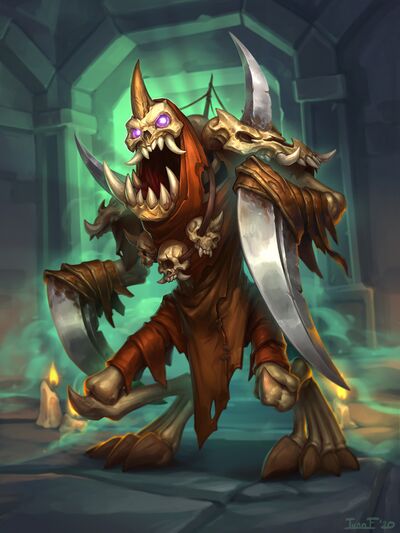

Rattlegore
Rattlegore is a mighty bone golem found in both versions of Scholomance, a rare, large skeleton with bent legs, a giant skull and scythes for hands. In the original iteration of Scholomance, Rattlegore is found after fighting Jandice Barov in a location called the Great Ossuary, a room filled with a gigantic pile of bones and corpses. The mighty Rattlegore needed to be defeated to obtain a key that would unlock other parts of Scholomance. During Cataclysm, Rattlegore participated in the Scourge assault on the town of Andorhal, menacing the town hall, but was slain by Alliance members.
When Scholomance was revamped during Mists of Pandaria, Rattlegore was noted to be recreated by Darkmaster Gandling from the supply of bones in Scholomance. Rattlegore was rebuilt to become more ferocious, and is imbued with a newfound desire to harvest raw materials from his enemies. During the storyline as adventurers assist Lilian Voss and the floating skull of Alexei Barov in cleansing Scholomance, Gandling would summon Rattlegore to attack adventurers while he deals with Lillian Voss. His Hearthstone summon quote of yelling his name really loudly is taken from his aggro line in WoW.


Vectus
In the original iteration of Scholomance, Vectus was a level 42 skeleton mage boss, noted to be one of the main teachers of necromancy there. Vectus is also responsible for the creation and experimentation with dragon eggs, creating the Plagued Dragons found in several segments of Upper Scholomance. Vectus gets his supply of dragon eggs from a goblin smuggler that brings them from Blackrock Spire. When encountered by adventurers in the Viewing Room, Vectus is giving a lecture on training and feeding meat of slowly-and-painfully-killed humanoids to the plagued dragonflight. Adventurers would fight Vectus and his comrade, the death knight Marduk Blackpool. Neither of them survived this, and were apparently sufficiently destroyed by adventurers and did not return in the Mists of Pandaria version of Scholomance. Again, the Hearthstone art depicts Vectus when he was alive.



Ras Frostwhisper
Ras Frostwhisper first appeared in Warcraft III as one of the randomly-generated names for Lich heroes, and could conceivably be encountered at various points where the various different forces in conflict during the Third War engaged and fought the undead Scourge. World of Warcraft would significantly expand on Ras Frostwhisper, turning him into an actual character. In life, Ras Frostwhisper was a human mage from Stormgarde, but was a rogue wizard who was not associated with Dalaran. He was recruited by the Cult of the Damned and climbed its ranks eagerly, slit his own throat with a grin during the culling of Stratholme. This act was rewarded by the Lich King, turned into one of the most powerful undead types -- the mighty lich. As a lich, Ras Frostwhisper became a lieutenant and favoured pupil of Kel'Thuzad, Ras Frostwhisper remained in Scholomance as essentially a guide to Darkmaster Gandling.
Ras Frostwhisper first appeared in Warcraft III as one of the randomly-generated names for Lich heroes, and could conceivably be encountered at various points where the various different forces in conflict during the Third War engaged and fought the undead Scourge. World of Warcraft would significantly expand on Ras Frostwhisper, turning him into an actual character. In life, Ras Frostwhisper was a human mage from Stormgarde, but was a rogue wizard who was not associated with Dalaran. He was recruited by the Cult of the Damned and climbed its ranks eagerly, slit his own throat with a grin during the culling of Stratholme. This act was rewarded by the Lich King, turned into one of the most powerful undead types -- the mighty lich. As a lich, Ras Frostwhisper became a lieutenant and favoured pupil of Kel'Thuzad, Ras Frostwhisper remained in Scholomance as essentially a guide to Darkmaster Gandling.
The ghost of Magistrate Marduke, one of the former residents of Scholomance, has a plan to destroy Ras Frostwhisper because he recognizes the lich as being one of the leading figures of Scholomance. Marduke would send adventurers to gather items from Ras Frostwhisper's life as a human and secure the aid of Argent Dawn member Leonid Bartholomew to create a Soulbound Keepsake that reverts Ras back into his human form, making him mortal and able to be killed. This ended Ras Frostwhisper's threat permanently, because he was not seen in the revamped version of Scholomance.


Lorekeeper Polkelt
Ironically, Lorekeeper Polkelt doesn't actually have much lore around him. Polkelt appears in the original iteration of Scholomance, in the Lower Scholomance sub-zone, as one of the six sub-bosses that needed to be defeated before Darkmaster Gandling, the final boss, appears. When the adventurers arrive to take down Lorekeeper Polkelt, he is merely a shambling, brainless zombie. Hearthstone's version of Lorekeeper Polkelt shows that he was, true to his title, a mage that is concerned with keeping scrolls of knowledge.


"Soulciologist"/Instructor Malicia
While her title of "Soulciologist" is obviously a play on words on Hearthstone's part, Instructor Malicia is a high elven necromancer in the original version of Scholomance, a level 43 boss that is one of the six sub-bosses in Lower Scholomance that adventurers have to defeat to summon Darkmaster Gandling. There's really not a lot of lore around her beyond being just a necromancer instructor that used a combination of necromancer and priest spells in combat. During the events of Cataclysm, Instructor Malicia has moved out of Scholomance and leads a contingent of cultists in 'field training' as part of the the Western Plaguelands campaign. Malicia herself is located in Malicia's Outpost. Field Agent Kaartish of the Argent Crusade tasks adventurers in curbing Malicia's training, sending adventurers to ultimately slay Malicia and uncover clues to the inner working of Scholomance and allowing adventurers to progress in a series of questlines in taking down Scholomance's infrastructure.
While her title of "Soulciologist" is obviously a play on words on Hearthstone's part, Instructor Malicia is a high elven necromancer in the original version of Scholomance, a level 43 boss that is one of the six sub-bosses in Lower Scholomance that adventurers have to defeat to summon Darkmaster Gandling. There's really not a lot of lore around her beyond being just a necromancer instructor that used a combination of necromancer and priest spells in combat. During the events of Cataclysm, Instructor Malicia has moved out of Scholomance and leads a contingent of cultists in 'field training' as part of the the Western Plaguelands campaign. Malicia herself is located in Malicia's Outpost. Field Agent Kaartish of the Argent Crusade tasks adventurers in curbing Malicia's training, sending adventurers to ultimately slay Malicia and uncover clues to the inner working of Scholomance and allowing adventurers to progress in a series of questlines in taking down Scholomance's infrastructure.
Malicia is also featured in the card art of School Spirits.


Dr. Theolen Krastinov
Doctor Theolen Krastinov, also known by his title of 'the Butcher', is a level 42 elite living human in the original version of Scholomance, wielding two blood-stained butcher's knives and one of the six sub-bosses in Lower Scholomance alongside Malicia, Polkelt, the Ravenian, Alexei Barov and Illucia Barov. Krastinov worked as a minion of Kirtonos the Herald, one of the Scourge lieutenants in Scholomance, and mainly acted as a torturer and procurer of bodies for Scholomance's necromancy experiments. Doctor Krastinov made good on his title as the butcher, torturing and killing the servants of Caer Darrow, many of whom died cursing him and being trapped as vengeful ghosts. Krastinov was slain by the adventurers that arrived to take down Scholomance. However, during the Mists of Pandaria revamp of Scholomance, Darkmaster Gandling raised Dr. Krastinov and turned him into an undead being. As violent in undeath as he was as a living person, Krastinov now resides in the Butcher's Sanctum as a 'rare boss' in the new Scholomance, responsible for the creation of the abominations and flesh beasts in Scholomance.



Lord Alexei Barov
The final lord of House Barov, Alexei Barov sold his family and mansion to the Cult of the Damned, eventually seeing his family and his people turned into undead monstrosities that serve the Scourge. His wife Illucia and his daughter Jandice were raised as ghosts, while Alexei Barov was turned into a mighty death knight, one of the first seen in Azeroth after the events of the Third War. Mindlessly serving the Scourge, Lord Alexei Barov guards the Barov Family Vault in the original iteration of Scholomance, and is one of the six sub-bosses needed to be defeated to draw out Darkmaster Gandling.
Upon the destruction of Alexei's death knight body, his spirit roamed Scholomance in the form of an enigmatic Talking Skull. During Mists of Pandaria, Alexei would appear to aid adventurers as the Talking Skull in navigating through Scholomance. Alexei would direct the adventurers in taking out the Scourge leaders in Scholomance, including the spirit of his daughter, as well as informing adventurers on how to remove the curse that afflicts Scholomance. Eventually, upon the adventurers' slaying of Darkmaster Gandling, the curse on Alexei Barov is lifted and he's able to pass on to the afterlife in peace.
Lord Barov is also featured in the card art of Commencement.


"Mindrender" Lady Illucia Barov
While the title of "Mindrender" is original to Hearthstone, Lady Illucia Barov was the wife of Alexei and the mother of Jandice. Guarding the Shadow Vault area, she is one of the six sub-bosses needed to be slain to summon Darkmaster Gandling in the original version of Scholomance. Lady Illucia was a level 43 boss that uses shadow priest spells exclusively. Lady Illucia's spirit was apparently put to rest prior to Mists of Pandaria, because she is absent from the revamped version of Scholomance.
Lady Illucia is also featured in the card art for Initiation.
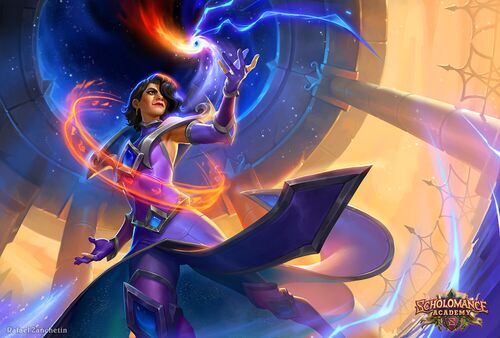

Instructor Chillheart (a.k.a. Instructor Fireheart)


Instructor Chillheart (a.k.a. Instructor Fireheart)
While she is called "Instructor Fireheart" in Hearthstone when she was alive, in World of Warcraft, she is known as Instructor Chillheart, a powerful female lich that serves as the first boss fight of the Mists of Pandaria version of Scholomance. Located in the area known as the Reliquary, Instructor Chillheart was sent and has arrived from Northrend to teach the necromancer students some discipline in her course of Instruction to the Dark Arts. She's known for being harsh on her students. When adventurers come and fight her, upon the destruction of her skeletal body, Instructor Chillheart's soul retreats to her phylactery which would animate the nearby books to attack the adventurers. This would not save Chillheart, who found her phylactery -- and her soul -- dispatched by the adventurers.


Professor Slate
Professor Slate, the Potions Master, is a named mad-scientist mob found in the Viewing Room in the Mists of Pandaria version of Scholomance. Slate is surrounded by a group of bored students, and would engage the adventurers that came to rid Scholomance of its undead minions. During the battle, Slate would make use of his potions to either wound the adventurers or bulk himself up, but would ultimately be slain by the adventurers. Like many of the undead bosses, Slate's Hearthstone card depicts him pre-death.
Professor Slate, the Potions Master, is a named mad-scientist mob found in the Viewing Room in the Mists of Pandaria version of Scholomance. Slate is surrounded by a group of bored students, and would engage the adventurers that came to rid Scholomance of its undead minions. During the battle, Slate would make use of his potions to either wound the adventurers or bulk himself up, but would ultimately be slain by the adventurers. Like many of the undead bosses, Slate's Hearthstone card depicts him pre-death.
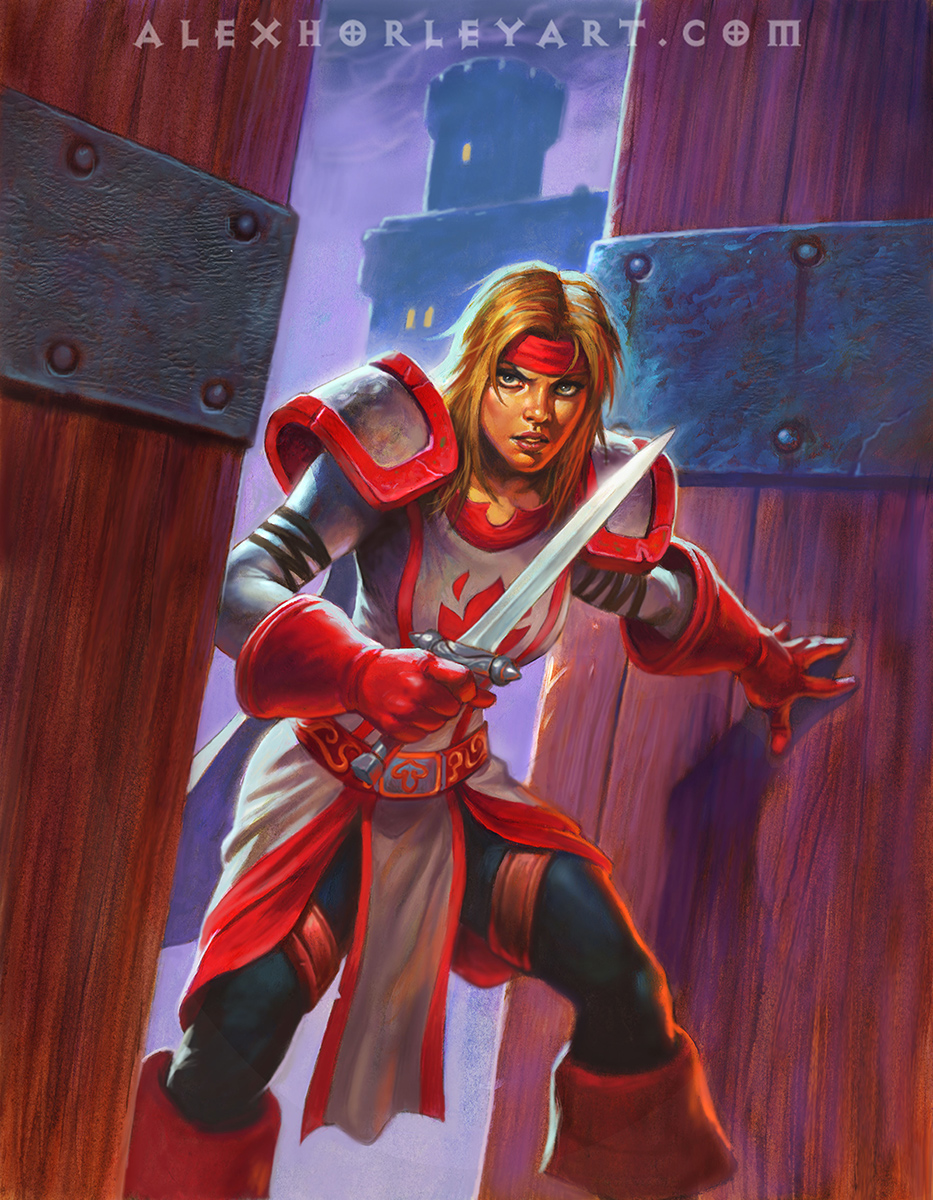

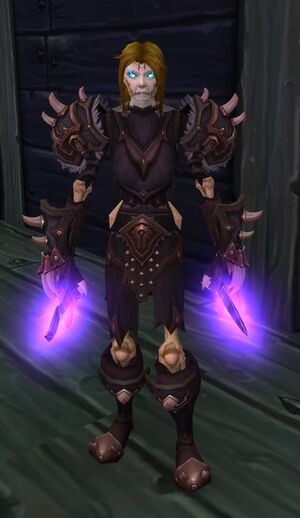
Infiltrator Lilian Voss
We have covered, for the most part, Lilian Voss's story when she first showed up in Hearthstone in Knights of the Frozen Throne. To quickly recap -- Lilian was a former prospective member of the Scarlet Crusade (depicted here in her "Infiltrator Lilian" form), but was killed and raised as a Forsaken. Taking some time to come to grips with her new status as an undead, Lilian would encounter a newly-risen Forsaken adventurer and would come to terms with her new status as a Forsaken. She would appear in Mists of Pandaria and aid adventurers in the Scarlet Monastery raid, and, most relevant to this expansion, aid adventurers in storming Scholomance. Lilian wanted to slay Darkmaster Gandling in particular, but was instead mind-controlled and forced to fight the adventurer, serving as the penultimate boss fight in the revamped Scholomance. Afterwards, Lilian would be freed from Gandling's influence.
Lilian would briefly have a minor appearance in Warlords of Draenor before being heavily involved in Legion's Rogue storyline, where it's revealed that Lilian is a member of the Uncrowned, a Rogue organization. During Battle for Azeroth, Lilian returned and formally serves in the Forsaken/Horde army. While her true loyalties lie with the Uncrowned (who are essentially trying to reshape the fate of the rulers of the world), Lilian Voss also recognized that the Forsaken leader Sylvanas Windrunner was planning to raise more Forsaken, something that Lilian approved. Lilian adopted a stance of hatred against human kingdoms at this point, believing that they fostered malice and hatred towards Forsaken, and participated in the Forsaken attack of the Kul Tiran town of Bridgeport. Alongside Nathanos Blightcaller and Rexxar, Lilian would go and hunt down the grave of one of the highest-ranking soldiers in that town, although she and Rexxar ended up making a deal to spare the lives of the wife and children of Thomas Zelling. As a Forsaken hero had been a mentor to her before, so did Lilian serve as a mentor to these newly-created Forsaken. While Lilian understood the need for Sylvanas in seeing her troops as essentially 'arrows in her quiver', she did not agree with her leader's stripping of some of the Forsakens' will. Ultimately, Sylvanas Windrunner would clash with other members of the Horde and abandon not only the Horde, but also the Forsaken. Lilian, realizing that the Forsaken needed to regain their allies' trust, ended up engineering a series of meetings with several other important undead figures, among them Calia Menethil and Derek Proudmoore. While not seen, it's implied that Lilian ended up helping to reconstruct the Forsaken people's infrastructure in the wake of Sylvanas' abandonment, and Lilian Voss ended up representing the Forsaken on the council that led the Horde.

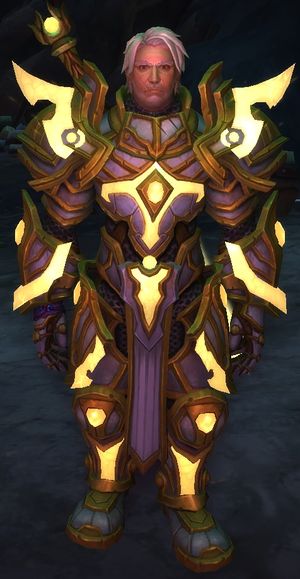

Turalyon, the Tenured
Turalyon is one of the longest-running characters in the Warcraft franchise. Originally training as a priest under Archbishop Alonsus Faol, Turalyon would swiftly become one of the main parts of the Second War's Alliance army, serving the army with distinction. He was responsible for bringing the orphaned Varian Wrynn before the various kings of the human nations and gave a speech that led them into forming the first Alliance. Turalyon would later become one of the first five original Paladins of the Silver Hand (alongside Uther, Tirion, Gavinrad and Dathoran), notable for being the only priest among them instead of a knight. Turalyon would be instrumental in the Second War as a commander, and would kindle a romance with the high elven general Alleria Windrunner. When Supreme Alliance Commander Anduin Lothar was killed by the Horde warchief Orgrim Doomhammer, it was Turalyon who rallied the Alliance with Lothar's broken sword and struck the decisive blow that shattered the Old Horde and sent them retreating and ending the Second War. During the events of Beyond the Dark Portal, Turalyon (one of the few 'hero' units in Warcraft II) led an expedition of elite Alliance troops called the Sons of Lothar to travel to Draenor. Turalyon achieved a series of victories in the campaign, driving the remnants of the Horde to desperation. The leader of the Horde on Draenor, Ner'zhul, unleashed a powerful spell that ripped the world apart, splitting Draenor into the collection of floating landmasses now known as Outland. After sealing the Dark Portal, Turalyon and his lover, the high elf ranger Alleria Windrunner, were separated from their companions and were presumed dead for decades. Statues of them and the other heroes of the Second War decorated Stormwind City.
Unknown to the rest of the world until the events of Legion, Turalyon and Alleria were teleported into the twisting nether where they met the prime naaru Xe'ra and the Army of the Light, finding themselves separated from the normal flow of time. Joining the Lightforged, Turalyon and Alleria fought the Burning Legion in the Twisting Nether for what, to them, was a thousand years. They fought the war, looking for a way to end the threat of the Burning Legion permanently. Despite being a human, Turalyon was touched by the Light and was able to lived far, far longer than a human would, apparently ascending into an 'eternal protector of creation'. Meanwhile, Alleria instead grew more powerful in the power of the Void, the opposite on the opposite spectrum of the Light, something that caused a massive rift between the pair. Alleria left the Army of the Light, while Turalyon became High Exarch. While Turalyon eventually learned to accept his wife, the prime naaru Xe'ra refused to and imprisoned her. While they were separated by time and space, Turalyon managed to eventually contact his son Arator and his former companion Khadgar. Turalyon and a freed Alleria finally reunited with the rest of Azeroth's champions during the events of Legion, where the Army of the Light arrived at the same time with the army of Azeroth to assault the Legion homeworld of Argus. Turalyon and Alleria met with their old allies, Turalyon would continue to fight the Legion on Argus, and participated in many of the fights there. Ultimately, after witnessing that the naaru are in fact fallible and realizing that there was much that Xe'ra (who died attempting to force Illidan Stormrage into a Light-infused being) had hidden from him, Turalyon's faith in the naaru are shaken. Ultimately, after the destruction of Argus, Turalyon and Alleria finally set foot in their home world, a thousand years after leaving it behind. Turalyon would help Varian Wrynn as an advisor, and his views in the Light would be further challenged when he saw that his old mentor, Alonsus Faol, was a Forsaken priest who was still able to wield the Light.
During Battle for Azeroth, Turalyon petitioned for the inclusion of the Lightforged draenei into the Alliance, and would later participate in the Battle for Stormgarde where he scoffs at the idea of a Horde Paladin upon encountering Lady Liadrin. After the conclusion of Battle for Azeorth, Turalyon was promoted by Anduin into Lord Commander of the Alliance forces, and Turalyon headed off to hunt down Sylvanas Windrunner.



Keymaster Alabaster, Archwitch Willow, High Abbess Alura
Keymaster Alabaster, Archwitch Willow and High Abbess Alura are all original to Hearthstone. Alabaster and Willow are humans so they could conceivably hang out as part of the Cult of the Damned, but High Abbess Alura, being a Draenei (pure Draenei didn't crash-land on Azeroth until Burning Crusade) couldn't have served in Scholomance when everyone was still alive. Still, Hearthstone rules.
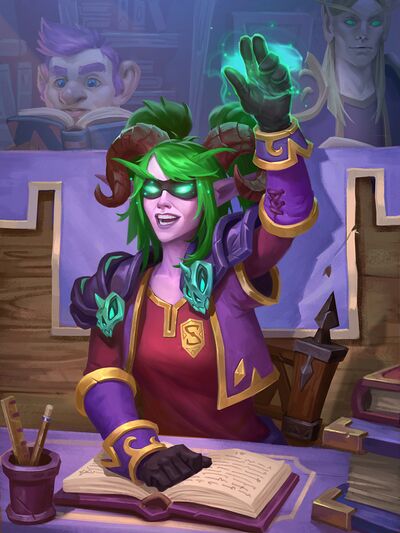
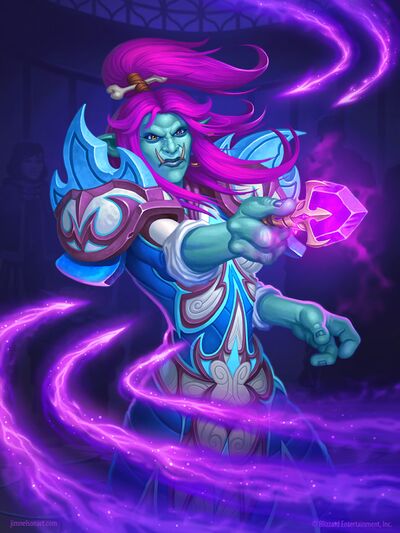

Star Student Stelina, Mozaki Master Duelist, Ace Hunter Kreen
Star Student Stelina, Mozaki the Master Duelist and Ace Hunter Kreen are all original to Hearthstone. Again, night elves were not wide-spread in the Eastern continent until near the end of the Third War, and demon hunters don't become widespread until all the way to Legion. Note that Ace Hunter Kreen is a tribute to real-life 2018/2019 Hearthstone world champion Hunterace.



Speaker Gidra, Shan'do Wildclaw, Forest Warden Omu
Speaker Gidra, Shan'do Wildclaw and Forest Warden Omu are all original characters too. The Tauren wouldn't have made contact with the eastern lands either at the point in Scholomance where everyone's alive.
Forest Warden Omu is the first representative of the Botani race in Hearthstone, a race of plant-based, bark-skinned humanoids native to Draenor. Omu herself is original to Hearthstone, and the Battlegrounds skin "Faewarden Omu" would reveal that she would join the Shadowlands faction called the Night Fae.
Introduced in Warlords of Draenor, the Botani serve giant plant-beings called the Genesaur and are notorious for their ability to infest organic humanoid races with spores that will turn them into shambling plant-beings. As part of the plant and fungal based collection of races known as the Primals, they continually wage war with the Breakers in alternate Draenor. In the prime timeline, it's noted that the Botani were completely wiped out by the march of the First Horde, with the Bleeding Hollow clan credited for the Botani's extinction. However, during Battle for Azeroth it's revealed that some Botani have arrived from the alternate-universe Draenor to Azeroth.
___________________________
OTHER MINIONS:



Plagued Proto-Drake: The necromancers of Scholomance, under the directions of Vectus, have been experimenting on black dragon eggs to make the Plagued Hatchlings. The Plagued Protodragons, meanwhile, were protodragons on Northrend that have been similarly corrupted by the Scourge's Blight, transforming them into servants of the Scourge that primarily served the frost vrykuls. "Plagued Proto-Drake" was a specific mount that was a rare achievement reward for beating the Naxxramas raid.

Animated Broomstick: Enchanted, magical brooms could be seen in magic-inclined places in Azeroth, particularly blood elf areas where they move on their own to sweep up the floor. Some mounts and companion pets also take the form of brooms. No specific item or mob is called 'Animated Broomstick', however.

Manafeeder Panthara: The Panthara are cat-like beasts native to the planet of Argus that have prominent scale-like protrusions covered in mana-sensitive particulate. Thus, this leads them into devouring energy to survive, whether it be the energy within living things or other sorts of energy sources. Depending on their mood and how close they are to prey, Pantharas are known to be able to change colours. The Manafeeder Panthara are specific level 110 mobs located at Wakener's Enclave in Mac'Aree.

Lake Thresher: The Lake Thresher is a level 25 threshadon that is found in Lake Everstill of the Redridge Mountains. It's not part of any actual quest, however, and the Lake Thresher would disappear during Cataclysm, implying that it was wiped out during the changes to Azeroth.

Ogremancer: The flavour text for the Ogremancer calls him 'Krul', but there is actually an ogre necromancecr in the Mists of Pandaria version of Scholomance called Kormok. Kormok is a level 60 ogre necromancer who delights in summoning the souls of the banished dead. To tie in the connection even further, Kormok's voice lines are adapted into the Ogremancer's own lines.

Cult Neophyte: The Cult Neophytes are basically borrowing their names from the Scholomance Neophyte mobs, which are level 41-60 mobs found all over Scholomance.
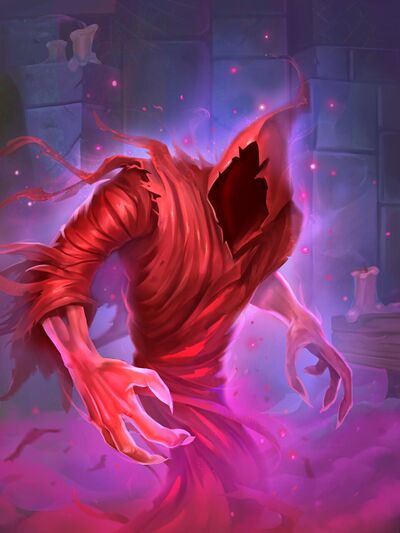

Spirit of Vengeance: While the artwork clearly depicts a wraith, the Spirit of Vengeance shares its name with a specific form of ghost summoned by the Warden heroes in Warcraft III. Wardens are able to create Avatars of Vengeance as part of their ultimate ability, which, in turn, would be able to raise the dead and create Spirits of Vengeance. They appear to fulfill a similar fashion in Legion as minions summoned by some Warden mobs.

Twilight Runner: The Twilight Runner is based on level 23-24 saber cats of the same name found in Stonetalon Mountains. Their whiskers were requested by a troll witch doctor, Jin'zil, to create a poison to kill a bunch of night elves.

Wolpertinger: This isn't the first Wolpertinger card in Hearthstone (that'd be one of the cards in the Gearmaster Mechazod Tavern Brawl), but the Wolpertinger, based on a real-life cryptid from Bavarian Folklore, shows up in World of Warcraft only in Brewfest. The strange winged and horned hares appear only in Brewfest, attracted by the scents of the festival, and can only be seen by drunk characters. The Wolpertingers are basically the target of some Brewfest-specific quests.

Marsuul Cub: The Marsuul are strange, adorable creatures vaguely similar to weasels that are native to Argus. Possessing tendril-like growths on its face and legs, as well as fins running down its back, for the most part Marsuuls behave like regular beasts, and some of them are hostile. Not much is known about them, but they're known to lay eggs, feed on fruit and make excellent pets.

Krolusk Barkstripper: The strange beings known as the Krolusk are native to the region of Vol'dun in Zandalar. Giant insects with a dinosaur-like mouth and a vaguely pillbug-shaped body, the Krolusks are massive insects that are domesticated by the local sethrak, who use the Krolusk as beasts of burden, mounts, battle pets and even food. No specific mob is called Krolusk Barkstripper, though one called a Krolusk Bonestripper does exist.

Boneweb Spider: In WoW, Bone Spiders are spiders seemingly made up of bone -- particularly in their legs. They are introduced in Wrath of the Lich King and primarily found in zones relating to undead nerubians. However, since then they've shown up in various other areas related to the undead.
Cabal Acolyte: The Cabal is a Outland-specific organization mostly consisting of orcs and Broken Draenei. The mobs called Cabal Acolytes are level 68-70 enemies found in the Shadow Labyrinth, but the Hearthstone card is clearly more of a reference to Classic Hearthstone card Cabal Shadow Priest.
Magehunter: The Magehunters in WoW are former members of the Kirin Tor that sided with the blue dragonflight during the Nexus War, serving them either because they share the views that mortals cannot use magic properly, or simply wanting to preserve their power after the war is over. The Maghunters have been transformed by Malygos -- some into drakonids -- and go out into the world to hunt down mortal mages and magical artifacts.
Molten Elemental: Molten Elementals are fire elementals introduced in Mists of Pandaria that appear during the battle with Wrathion in the Krasarang Wilds and Townlong Steppes.
Flesh Giant: Creatures called "Flesh Giants" in World of Warcraft are actually giant zombified bodies of actual giants (like Furnacefire Colossus, if we're using a Hearthstone example) or unique undead flesh beasts like Grobbulus. The artwork actually depicts what the game refers to as either a 'Flesh Beast' or a 'Mutated Abomination' (like Rotface!), far more savage and mutilated-looking variants of the regular abomination that also incorporate animal parts into their physiology.



The following minions are original to Hearthstone: Desk Imp, Intrepid Initiate, Pen Flinger, Tour Guide, Sneaky Delinquent, Wandmaker, Crimson Hothead, Divine Rager, Fishy Flyer, Wretched Tutor, Steward of Scrolls, Onyx Magescribe, Smug Senior, Sorcerous Substitute, Voracious Reader, Robes of Protection, Transfer Student, Educated Elekk, Enchanted Cauldron, Vilefiend Trainer, Soulshard Lapidary, Shardshatter Mystic, Ancient Void Hound, Gibberling, Bloated Python, Lab Partner, Firebrand, Wyrm Weaver, Judicious Junior, Goody Two-Shields, Argent Braggart, Frazzled Freshman, Shifty Sophomore, Vulpera Toxinblade, Diligent Notetaker, Totem Goliath, Shadowlight Scholar, Void Drinker, Troublemaker, Playmaker, Blood Herald, Teacher's Pet, Groundskeeper, Trick Totem, Wand Thief, Steeldancer, Devout Pupil and Brittlebone Destroyer.
The artwork for Teacher's Pet shows an Ironbeak Owl and an Emperor Cobra, specifically 3-cost beasts that it might summon. Cute!
Spirit Jailer's a Jailer Demon, which we briefly talked about in the Battlegrounds segment -- albeit a far, far cuter Jailer Demon than how they traditionally look. In a neat bit of Easter Egg, the Toothy Chest (from Kobolds & Catacombs) appears in Sneaky Delinquent's artwork, while Annoy-o-Tron (from Goblins vs. Gnomes) and Possessed Villager (from Whispers of the Old Gods) appears in Tour Guide. Divine Rager is, of course, the latest of the running Rager gag, the seventh collectible Rager. The Gibberling, of course, is another representative of the Hearthstone-original Gibberer creature first seen in Kobolds & Catacombs.
___________________________
SPELLS:


___________________________
SPELLS:

Soul Fragments: The "Soul Fragments", exclusive to Warlocks and Demon Hunters in Hearthstone, are loosely based on the Soul Shard mechanic in WoW. Warlocks use the 'Soul Shard' resource, which are generated by killing targets with certain spells, and are in turn consumed to cast other spells. The mechanics have changed over the years, and currently only Affliction Warlocks use Soul Shards. Meanwhile, the specific term 'Soul Fragment' has been used for the name of many various mobs and plot items, including, interestingly enough, a level 38 mob in Scholomance.
Double Jump: In WoW, Double Jump is a passive demon hunter ability gained at level 98, allowing a demon hunter to... well, double-jump. That is, to jump again near the apex of a first jump.
Glide: Another utility ability, Glide is also gained at level 98 by demon hunters, where when a demon hunter is falling, they can activate the Glide ability to reduce their falling speed. Demon Hunters can customize the type of wings that sprout while using Glide with specific glyphs.
Survival of the Fittest: Survival of the Fittest is the name of a level 90 passive Guardian-spec druid talent that reduces the cooldowns of other druid skills.

Combustion: Combustion is a level 40 Fire-spec mage ability, that, when activated, increases the critical strike chance of spells, grants extra mastery and also sets the Fire Mage on fire.
Brain Freeze: Brain Freeze is a level 28 Frost-spec mage passive ability that buffs the Frostbolt spells of the mage. At higher levels, Brain Freeze also applies extra debuffs.
Initiation: Initiation is a honor talent for multiple classes (mages, warlocks, balance druids, shadow priests, elemental shamans) that increases the critical chance of damaging abilities and attacks.




Molten Blast: Molten Blast is an artifact trait for Shamans' artifact weapons buffs Lava Burst. It's only active in Legion, like other artifact traits.
Tidal Wave: Tidal Wave is an ability in pet battle used by pets that can control water.
Potion of Illusion: Created by Alchemists at a sufficient skill level, the Potion of Illusion, when consumed, will turn those who consume it to look like another character.


The following spells are original to Hearthstone: Fel Guardians, Cycle of Hatred (it shares its name with a novel that bridges Warcraft III and World of Warcraft), Nature Studies, Partner Assignment, Carrion Studies, Overwhelm, Cram Session, First Day of School, Blessing of Authority, Draconic Studies, Power Word: Feast (apparently it depicts the 'son' of Priest of the Feast), Plagiarize, Secret Passage, Demonic Studies, School Spirits, Athletic Studies, In Formation, Demon Companion (based on Hearthstone's Animal Companion), Adorable Infestation (based on the Ultimate Infestation card), Guardian Animals, Lightning Bloom, Runic Carvings, Primordial Carvings, Devolving Missiles, Cutting Class, Coerce, Shield of Honor, Commencement, Wave of Apathy, Gift of Luminance, Soul Shear and Felosophy.
___________________________WEAPONS:
The following weapons are original to Hearthstone: Sphere of Sapience, Marrowslicer (which is visually based on Lord Marrowgar of Icecrown Citadel fame), Self-Sharpening Sword, Rune Dagger, Reaper's Scythe, Trueaim Crescent and Ceremonial Maul.
No comments:
Post a Comment